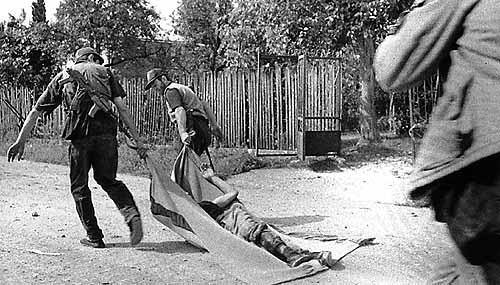In the current situation, one issue facing Georgia is what to do with and for the Internally Displaced People (IDPs) that are now coming from South Ossetia and the Kodori Gorge, in Upper Abkhazia. A friend with significant experience in development work posted a candid analysis in an e-mail group. We thought that the analysis is worth sharing since this issue affects the region.
So here is what he had to say:
——————————–
“I was speaking about this issue with some Georgian friends just yesterday. They have been involved in IDP shelter work with people from Abkhazia since the mid-1990s. I’ve done a bit of work with those shelters myself, and would STRONGLY encourage anybody getting involved with shelter issues now to visit some of these old shelters if they have not already done so, and not just in Tbilisi. Some of the shelters I saw in Kutaisi and Samegrelo were horrific. Families have been vegetating in them for fifteen years now, with every politician promising them return next year.
In our discussion, we came up with two big lessons learnt:
1. LESSON ONE: Don’t pretend it’s temporary
Yes, thankfully, most new IDPs – especially from Gori town – will go home soon. However, many IDPs in Georgia will not. It’s not going to happen. Live with it. They weren’t ethnically cleansed (houses burnt etc) to pave the way for their return, and Georgia lost the war. The Palestinians aren’t returning any time soon, either. No idea how many people this is – let’s say Kodori and South Ossetia. […] We’re prob talking 20,000 people minimum.
We should seek to identify those IDPs who will probably not go home soon, and seek durable, humane living conditions for them. Most of Georgia’s old IDP shelters are a patchwork of small interventions – an NGO puts in windows, a year later, another puts in floors, two years later there’s a new door. Look for yourself – this approach leads to crap results, not only in human terms, but also in terms of value for money. (Repeat assessments are one example – IDPs from Abkhazia have told me how sick they are of assessments by now.)
The key point to remember is that there will be loads of money coming in soon. After that, funds will dry up. By 2006, there was hardly any funding to be had for shelter work. Let’s spend it well NOW, while there is money to be spent.
The main prob is that the GoG will probably not look favourably on this approach. IDPs in misery desperate to go home bolster Georgia’s claim to these territories. One way to get round this would be to point out that should the IDPs return, the municipalities would get buildings in good shape, ready for privatization or social housing needs. Be diplomatic.
Urban Institute’s voucher project was good, but the Georgian housing market was a lot less elastic than they thought. Handing out vouchers to buy flats worth 5000 dollars each to a few hundred families sent housing prices rocketing in Kutaisi (it wasn’t enough to money to buy in Tbilisi or Batumi). Vouchers are not feasible on a large scale.
Privatization doesn’t solve anything either. One day, your family lives in a crap shelter. The next day, it lives in a crap shelter you own. Without money to renovate, it improves security of residence, but living conditions are exactly the same. How will 50 broke families ever be able to repair their communal roof?
The way I see it, the only humane option is to (1) do large-scale thorough rehabilitation of existing buildings, or (2) to build new housing from scratch (NRC has done the latter on a small scale). A nice side effect is that such large-scale, donor-funded construction efforts will generate a lot of employment in a sector that will be badly affected by the probable fall in investment after this war.
2. LESSON TWO: Don’t dump IDPs in depressed or remote areas
Placing people in “no future zones” like the town of Vani, where there is zero employment even for locals, is a bad idea. Also, some shelters in Samegrelo are in the middle of nowhere. Those IDPs who cannot escape get stuck there with nothing to do except to cry, to drink, or to do both. Some have been doing just that for over a decade now. Think poverty trap, think psychosocial problems, think domestic abuse. Also, microcredit or employment generation will not work in the back of beyond.
Maybe they should all be housed in Tbilisi?
————
That’s just my take, and that of some friends of mine. The history of sheltering IDPs from Abkhazia has created lots of “lessons learnt”. Ask your more experienced Georgian colleagues and LNGO partners what they think, and please do visit a few shelters from the 1990s outside Tbilisi before you start knocking out funky proposals. Let’s use the money that’s gonna pour in now wisely, because we are not going to get a second shot at this.
I would be extremely grateful if we could hear the thoughts of more people on this.”
—————————–
This, then, the comment of said person (who works in this field and therefore, for now, preferred not to be named). Any views?












